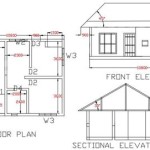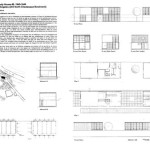Small 4 Bedroom 2 Story House Plans: Maximizing Space and Functionality
The demand for small 4-bedroom 2-story house plans has steadily increased in recent years. This trend reflects a growing desire for affordable housing that can accommodate growing families or provide ample space for various lifestyle needs without sacrificing land usage. This type of house plan offers a practical solution for individuals and families looking to optimize their living space within a smaller footprint, balancing affordability with the need for multiple bedrooms and functional areas.
A small 4-bedroom 2-story house plan is characterized by its efficient use of vertical space. By building upwards, the house occupies less land compared to a single-story dwelling with the same number of bedrooms. This is particularly beneficial in areas with high land costs or where lot sizes are restricted. These plans typically feature the main living areas, such as the living room, kitchen, and dining room, on the ground floor, while the bedrooms are located on the upper floor. This separation of living and sleeping areas contributes to better privacy and noise reduction.
Key Considerations When Choosing a Small 4 Bedroom 2 Story House Plan
Selecting the right small 4-bedroom 2-story house plan requires careful consideration of various factors. These factors encompass lifestyle needs, budgetary constraints, site characteristics, and local building codes. A thorough understanding of these elements will ensure the chosen plan aligns with the homeowner's long-term goals and provides a comfortable and functional living environment. Neglecting these aspects can lead to future dissatisfaction, costly modifications, and potential code violations.
One of the primary considerations is lifestyle. How the family intends to use the space is crucial. Does the family frequently entertain guests? Are there requirements for dedicated home office space? Are there specific needs for elderly or disabled family members? These questions will influence the layout and features of the house plan. For instance, a family that frequently entertains may prioritize a larger open-plan living and dining area, while a family with elderly members may need to consider accessibility features, such as a ground-floor bedroom and bathroom.
Budget is another critical factor. The cost of building a house varies significantly depending on location, materials, finishes, and labor costs. It is essential to establish a realistic budget before selecting a house plan and to factor in all associated expenses, including land acquisition, permits, construction costs, landscaping, and interior design. Obtain quotes from multiple builders and material suppliers to get an accurate estimate of the total project cost. Consider the long-term costs associated with owning the home, such as property taxes, insurance, and maintenance.
Site characteristics also play a vital role. The shape and size of the lot, the slope of the land, soil conditions, and local zoning regulations will all influence the type of house plan that can be accommodated. A sloped lot, for example, may require a different foundation design than a flat lot. Soil conditions can impact the cost of foundation construction. Zoning regulations may dictate setbacks, height restrictions, and other limitations. A professional site survey and consultation with a local architect or builder are recommended to assess the suitability of the site for the chosen house plan.
Compliance with local building codes is paramount. Building codes are designed to ensure the safety and structural integrity of buildings. They cover various aspects of construction, including foundation, framing, plumbing, electrical, and mechanical systems. Failure to comply with building codes can result in costly fines and delays in construction. It is the homeowner's responsibility to ensure that the chosen house plan meets all applicable local building codes. Engaging a licensed architect or engineer is highly recommended to ensure compliance.
Design Elements and Space Optimization
Effective design elements and space optimization techniques are crucial in small 4-bedroom 2-story house plans to maximize the usability and livability of the limited square footage. These strategies involve careful planning of the layout, incorporating multi-functional spaces, utilizing vertical storage solutions, and selecting appropriate materials and finishes. The goal is to create a home that feels spacious, comfortable, and efficient, despite its compact size.
Open-plan living is a common design element in small house plans. Combining the living room, dining room, and kitchen into a single open space creates a sense of spaciousness and allows for better flow between these areas. This arrangement also facilitates social interaction and makes it easier to supervise children. Careful consideration should be given to the placement of furniture and appliances to define distinct zones within the open space.
Multi-functional spaces are another key strategy for optimizing space. A guest bedroom can double as a home office or a playroom. A dining table can also serve as a workspace. A built-in window seat can provide seating and storage. By creatively designing spaces to serve multiple purposes, homeowners can make the most of every square foot. The use of modular furniture and adaptable storage solutions can further enhance the versatility of multi-functional spaces.
Vertical storage solutions are essential in small houses. Tall cabinets, shelving units that reach the ceiling, and loft spaces can provide ample storage without taking up valuable floor space. Utilizing the space above doorways and windows for shelving is another effective strategy. Consider incorporating built-in storage solutions, such as drawers under beds or benches with storage compartments. Maximizing vertical storage helps to keep the house clutter-free and organized.
The selection of appropriate materials and finishes can also contribute to space optimization. Light-colored walls and ceilings can make a room feel brighter and more spacious. Mirrors can create the illusion of depth. Streamlined and minimalist furniture designs can help to avoid a cluttered look. Selecting durable and low-maintenance materials can reduce the need for frequent repairs and replacements. Careful attention to detail in the selection of materials and finishes can significantly enhance the overall appearance and functionality of the house.
Foundation, Framing, and Roofing Considerations
The foundation, framing, and roofing systems are fundamental structural components of a house. Their design and construction directly impact the house's stability, durability, and energy efficiency. Selecting the appropriate foundation type, framing method, and roofing material requires careful consideration of site conditions, climate, budget, and aesthetic preferences. A well-designed and properly constructed structural system will ensure the long-term integrity and performance of the house.
The foundation type is determined by soil conditions, slope of the land, and local building codes. Common foundation types include slab-on-grade, crawl space, and basement foundations. Slab-on-grade foundations are suitable for flat lots with stable soil conditions. Crawl space foundations provide access for plumbing and electrical systems and can help to prevent moisture problems. Basement foundations offer additional living or storage space but are more expensive to construct. A geotechnical engineer should be consulted to assess soil conditions and recommend the appropriate foundation type.
The framing method refers to the structural system that supports the walls and roof of the house. Common framing methods include stick-built framing and prefabricated framing. Stick-built framing involves constructing the frame on-site using individual lumber pieces. Prefabricated framing involves assembling the frame in a factory and then transporting it to the site for erection. Prefabricated framing can be faster and more efficient than stick-built framing, but it may be more expensive. The choice of framing method depends on budget, time constraints, and availability of skilled labor.
The roofing material is selected based on climate, aesthetic preferences, and durability. Common roofing materials include asphalt shingles, tile, metal, and wood shakes. Asphalt shingles are the most affordable and widely used roofing material. Tile roofs are durable and aesthetically appealing but can be heavy and expensive. Metal roofs are highly durable and energy-efficient but can be noisy during rain. Wood shakes offer a natural look but require regular maintenance. The choice of roofing material should be based on a balance of cost, performance, and aesthetics.
Proper insulation and ventilation are crucial for energy efficiency and moisture control. Insulation helps to keep the house warm in the winter and cool in the summer, reducing energy consumption. Ventilation helps to remove moisture from the house, preventing mold growth and improving indoor air quality. The type and amount of insulation required depends on the climate zone. Proper ventilation can be achieved through natural ventilation, such as windows and vents, or through mechanical ventilation systems, such as exhaust fans and air exchangers. A well-insulated and ventilated house will be more comfortable, energy-efficient, and healthy.

4 Bedroom 2 Story House Floor Plans Elegant Two Home Designs Ideas

Pin On Cottage Floor Plans

4 Bedroom Small Plot Home Design With Free Plan Kerala Plans House Layout Modern

2 Story 4 Bedroom House Plans Tiny Floor Narrow Small Design

Beautiful 4 Bedroom 2 Y House Plans New Home Floor Plan

House Plan 4 Bedroom Plans Design Floor

Small House Plans Home Plan 4 Bedrms 2 Baths 1552 Sq Ft 170 1320

Small 4 Bedroom 2 Bath House Plans Arts Layouts Two Story New

Carlo 4 Bedroom 2 Story House Floor Plan Pinoy Eplans

House Design Plan 8 5x9 5m With 4 Bedrooms Home Small Exterior Model Construction








